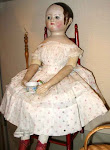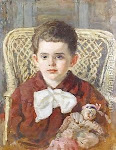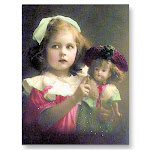England had 2 major classes: The aristocrats (those who inherited land and titles), and the commoners (everyone else). Still, most Victorians knew that their society was three-tiered.
In the upcoming posts I will show a sampling of the social classes that were present in Europe during the Victorian era.
Young Woman in a Boat, 1870 by James Tissot.
" They sat together in a window [of Thrushcross Grange] whose lattice lay back against the wall, and displayed, beyond the garden trees, and the wild green park, the valley of Gimmerton, with a long line of mist winding nearly to its top (for very soon after you pass the chapel, as you may have noticed, the sough that runs from the marshes joins a beck which follows the bend of the glen). Wuthering Heights rose above this silvery vapour; but our old house was invisible; it rather dips down on the other side. "
 “Top Withens This farmhouse as been associated with the novel “Wuthering Heights” the Earnshaw’s home in the Emily Bronte novel. The buildings even when complete bore no resemblance to the house she described, but the situation may have been in her mind when she wrote about the moorlands setting of the heights.
“Top Withens This farmhouse as been associated with the novel “Wuthering Heights” the Earnshaw’s home in the Emily Bronte novel. The buildings even when complete bore no resemblance to the house she described, but the situation may have been in her mind when she wrote about the moorlands setting of the heights.
A plaque has been placed at the sight by the Bronte society in response to many inquiries.
Social classes with a great deal of power are usually viewed as "the elites" within their own societies; as in Wuthering Heights, property and titles were very important assets. The hereditary land-owning class was made up of aristocrats and the gentry. In the case of the aristocrats, the title and land usually went to the oldest son. With nineteenth century moral reforms coming to the forefront, the upper-class life of leisure and enjoyment lost favor. During this period, when the oldest son received the land, he was expected to actually do something besides just mulling about, as it seems the characters Wuthering Heights did. He was expected to sit in Parliament, have a hand in local affairs, and use his influence in a charitable cause, even though he did not do any paid work.
 "Etiquette" is the one word that aptly describes life during the reign of Queen Victoria.
"Etiquette" is the one word that aptly describes life during the reign of Queen Victoria.
“We Victorians take the rules of propriety very seriously. It is who we are. If one does not conform they are considered outcasts in proper society.”
For those in the upper echelons of society, rules such as the proper forms of address, and even what to wear, were all considered very important.

Christmas morning in a gentry household.
 Most important however, were the landed gentry. A landed estate included a hall or manor house, a home farm that was managed by a bailiff, several farms that were occupied by tenants, and a village or two in which farm laborers lived. The landed gentleman usually did not have a house in town. He spent most of the year on his estate, taking an active position on local issues. Generally, he was called "Squire"
Most important however, were the landed gentry. A landed estate included a hall or manor house, a home farm that was managed by a bailiff, several farms that were occupied by tenants, and a village or two in which farm laborers lived. The landed gentleman usually did not have a house in town. He spent most of the year on his estate, taking an active position on local issues. Generally, he was called "Squire"
During this time period, there were about two thousand squires with estates of between one thousand and three thousand acres. The squire was expected to be a justice of the peace and to take interest in the countryside, and also to promote local charities.

French Jumeau


The aristocracy formed a separate class under law. The children of aristocrats were also aristocrats with special rights.
Lady Sybil Myra Caroline Grant (1879–1955) was a Bristish writer, designer and artist. She was the eldest child of Archibald "Archie" Primrose, 5th Earl of Rosebery and his wife Hannah ( nee de Rotheschild) Lady Sybil married, on 28 March 1903, General Sir Charles John Cecil Grant (1877–1950).
On the death of her father in 1929, she inherited his estate, "The Durdans" at Epsom, which became her home. Grant later became an eccentric, spending most of her time in a caravan or up a tree, communicating to her butler through a megaphone. She died a widow in 1955, survived by her son, Charles Robert Archibald Grant, who had married Honourable Pamela Wellesley (born 14 May 1912), granddaughter of the 4th Duke of Wellington.
Afternoon Tea
 From the time tea was first imported into England, sharing tea with a convivial group was an excuse for good food and conversation among both men and women. Afternoon Tea as a social event was introduced in England by Anna, the seventh Duchess of Bedford, in the year 1840. Anticipating dinner after 8 PM each day, the Duchess asked that a tray of tea, bread and butter, and cake be brought to her room during the late afternoon. As this became a habit, she began inviting friends to join her. This formal pause quickly developed into a fashionable social event and spread to all parts of England . Service was highly stylized, with very specific rituals for serving the tea, usually in the drawing room between four and five o'clock. The occasion called for pleasant conversation among the prettiest table settings, providing the hostess an opportunity to show off her best china and linens and to serve her most delicate cookies and cakes.
From the time tea was first imported into England, sharing tea with a convivial group was an excuse for good food and conversation among both men and women. Afternoon Tea as a social event was introduced in England by Anna, the seventh Duchess of Bedford, in the year 1840. Anticipating dinner after 8 PM each day, the Duchess asked that a tray of tea, bread and butter, and cake be brought to her room during the late afternoon. As this became a habit, she began inviting friends to join her. This formal pause quickly developed into a fashionable social event and spread to all parts of England . Service was highly stylized, with very specific rituals for serving the tea, usually in the drawing room between four and five o'clock. The occasion called for pleasant conversation among the prettiest table settings, providing the hostess an opportunity to show off her best china and linens and to serve her most delicate cookies and cakes.
Victorian prosperity for the elites, was built on the development of new machinery, new work methods and an underpaid workforce consisting of adults and children living in wretched poverty.













































.jpg)

























































































Mas o menos como ahora en muchos paises...
ReplyDeletePasando a lo frívolo: Me encantan los dibujos de Anton Pieck!!! hace años compré en un antiquario una de sus láminas para calendarios.
Un abrazo con mar y sol desde BCN
Maria
oh, thank you very much. This is very interesting.
ReplyDeletewww.maijaandme.blogspot.com
Lovely post. Sybil looks lovely. Victorian etiquette is a very strange thing indeed, the more you study it and it changed often irrationally. You use such lovely images.
ReplyDeleteThe evolution of mankind is forever fascinating, and this little lesson today is indeed just that. Good work!
ReplyDeleteThank you all...This blogs have been most interesting to research. I'm fascinated by Victorian England and of course the dolls that were manufactured during those years for those "lucky aristocrat children."
ReplyDeleteStay tune for the rest of Victorian social echelons
Hugs
Marta
Such wonderful photos and commentary --I thoroughly enjoyed this post. Thank you!
ReplyDeleteYou must have liked the movie SOMEWHERE IN TIME, my favorite, the music is wonderful and your post is just fabulous. Beautiful images.. Thank you for a beautiful trip.
ReplyDeleteyvonne